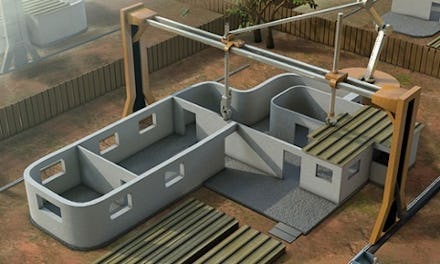Major Breakthrough in 3-D Printing Could End One of the World's Biggest Issues

Amsterdam's Dus Architects is attempting to revolutionize the construction industry forever with major work towards what they're claiming will be the world's first fully 3-D-printed house. Complete with 13 rooms made of interlocking plastic parts and reinforced by concrete for support and insulation, the expected three-year process of assembling the domicile has already begun.
"The building industry is one of the most polluting and inefficient industries out there," Dus' Hedwig Heinsman told The Guardian. "With 3-D-printing, there is zero waste, reduced transportation costs, and everything can be melted down and recycled. This could revolutionize how we make our cities."
The project relies on a technology called KamerMaker (Room Builder), which Dutch firm Ultimaker designed as a scaled-up version of a typical home 3-D printer capable of assembling blocks up to 2x2x3.5m high. It squirts a bio-plastic mix that usually is put to work as an industrial adhesive, but the device is also capable of printing with other materials such as other forms of plastic and a liquid form of fibreboard. After three weeks of work, the architects have managed to assemble a three meter-high corner of the house printed as a single piece weighing 180kg (roughly 400 lbs).
This is what the process looks like:
According to Heinsman, "This is only the beginning, but there could be endless possibilities, from printing functional solutions locally in slums and disaster areas, to high-end hotel rooms that are individually customised and printed in marble dust."
"One of my fantasies is printing in biodegradable materials for festivals," she added. "You could print an outrageous tent structure, then after a couple of years and few rain showers it disappears."
But another exciting development could be low-cost temporary housing for the homeless. A recent UNCC study in Charlotte, N.C. found that while a chronically homeless person costs society up to $39,458 annually in medical and judicial costs, simply giving them a decent place to live with adequate social support can dramatically reverse their situation. According to the study, a $6 million facility for the homeless named Moore Place was able to save approximately $1.8 million a year as well as enable 82% of its residents to generate income. So there's a precedent for the idea that providing affordable housing to the homeless lowers costs to society in general. But just how cheap could 3-D-printed housing be?
Even more recently, Shanghai-based engineering company WinSun claims to have 3-D-printed a small village of 10 200-square-meter concrete buildings for just $4,800 each. WinSun CEO Ma YiHe says that the company plans to source future construction supplies from a network of 100 recycling factories which will process construction and industrial waste into printer-ready building materials. He also estimates that 3-D printing will save 50% on traditional construction costs.
Building cheap, affordable homes would only solve part of the homelessness problem, which the U.S. government could be doing much more to tackle even before adopting new technologies. For example, a poster on StackExchange's Skeptics board noted that while the National Alliance to End Homelessness claims 633,782 individuals across the U.S. are without shelter on any given night, there are nearly 14 million residences that remain vacant year-round. That's as many as 22 vacancies per homeless person on a given night. But whether these units are in livable conditions or rotting from the inside or even located in areas where the chronically homeless live is another story entirely, leaving 3-D printing as a potentially attractive future solution to homelessness in areas without convertible structures or access to cheap land.
And in places like India with far worse problems with homelessness (one in 100 city dwellers lack a home, while 170 million languish in slums), low-cost, easily replicable tools like 3-D-printed houses could make a big impact on quality of life.